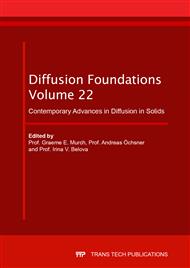[1]
J.R. Manning, Diffusion Kinetics for Atoms in Crystals (Princeton, NJ: Van Nostrand) (1968).
Google Scholar
[2]
J.R. Manning, Phys. Rev. B, Vol. 4 (1971), p.1111.
Google Scholar
[3]
J.R. Manning, Can. J. Phys., Vol. 46 (1968), p.2633.
Google Scholar
[4]
J.R. Manning, Phys. Rev. Vol. 139 (1965), p.A2027.
Google Scholar
[5]
J.R. Manning, Acta Met., Vol. 15 (1967) p.817.
Google Scholar
[6]
R.E. Howard and J.R. Manning, Phys. Rev. Vol. 154 (1967) p.561.
Google Scholar
[7]
J.R. Manning, Met. and Mat. Trans. B, Vol. 1 (1970) p.499.
Google Scholar
[8]
J.R. Manning, Phys. Rev. Vol. 124 (1961) p.470.
Google Scholar
[9]
J.R. Manning, Diffusion Kinetics and Mechanisms in Single Crystals, Geochemical Transport and Kinetics, ed. A. W. Hofmann, B.J. Giletti, H.S. Yoder Jnr. and R.A. Yund, (Carnegie Inst. Washington Publications 634, pp.3-13 (1974).
Google Scholar
[10]
J.R. Manning, Phys. Rev. Vol 139 (1965) p. A126.
Google Scholar
[11]
J.R. Manning, Phys. Rev. Vol 125 (1962) p.103.
Google Scholar
[12]
G.E. Murch and R.J. Thorn, Phil. Mag. A, Vol. 39 (1979), p.259.
Google Scholar
[13]
A. R. Allnatt and A.B. Lidard, Atomic Transport in Solids (Cambridge University Press), (1993).
Google Scholar
[14]
G.E. Murch and I.V. Belova, Phil. Mag. A, Vol. 81 (2001), p.83.
Google Scholar
[15]
I.V. Belova, T. Ahmed, U. Sarder, A. V. Evteev, E.V. Levchenko, G.E. Murch, Phil. Mag. Vol.97 (2017) p.230.
Google Scholar
[16]
L.S. Darken, Trans. AIME, Vol. 180 (1948), p.430.
Google Scholar
[17]
L.K. Moleko, A.R. Allnatt and E.L. Allnatt, Phil. Mag. A, Vol. 59 (1989), p.141.
Google Scholar
[18]
I.V. Belova and G.E. Murch, Phil. Mag. A, Vol. 81 (2001), p.1749.
Google Scholar
[19]
A.R. Allnatt and E.L. Allnatt, Phil. Mag. A, Vol. 49, (1984), p.625.
Google Scholar
[20]
G.E. Murch, Phil. Mag. A, Vol. 46 (1982) p.575.
Google Scholar
[21]
I.V. Belova and G.E. Murch, Defect and Diffusion Forum, Vols. 273-276 (2008) p.431.
Google Scholar
[22]
A.B. Lidiard, Acta Met., Vol. 34 (1986) p.1487.
Google Scholar
[23]
K.L. Gosain, D.K. Chaturvedi. I.V. Belova and G.E. Murch, Defect and Diffusion Forum, Vols. 251-252 (2006) p.69.
DOI: 10.4028/www.scientific.net/ddf.251-252.69
Google Scholar
[24]
T.R. Paul, I.V. Belova, E.V. Levchenko, A.V. Evteev and G.E. Murch, Diffusion Foundations, Vol. 4 (2015), p.25.
Google Scholar
[25]
I.V. Belova and G.E. Murch, Phil. Mag. A., Vol. 81 (2001) p.1749.
Google Scholar
[26]
I.V. Belova and G.E. Murch, Phil. Mag. A., Vol. 80 (2000) p.1469.
Google Scholar
[27]
G.E. Murch and Z. Qin, Defect and Diffusion Forum, Vols. 109-110 (1994), p.1.
Google Scholar
[28]
G.E. Murch and C. M. Bruff, Chapter 5 in Diffusion in Solid Metals and Alloys, edited by H. Mehrer, Landolt-Bornstein, Group III, Condensed Matter, Vol 26, 1990, Springer.
DOI: 10.1007/b37801
Google Scholar
[29]
I.V. Belova and G.E. Murch, Acta Mat., Vol. 55 (2007), p.627.
Google Scholar
[30]
G.E. Murch, Solid State Ionics, Vol. 7 (1982), p.177.
Google Scholar
[31]
H. Sato and R. Kikuchi, J. Chem. Phys., Vol. 55 (1971) p.677.
Google Scholar
[32]
M. Chemla, Ann. Phys., Paris, Vol. 13 (1956), p.959.
Google Scholar
[33]
A.W. Imre, S. Voss and H. Mehrer, J. Non-Cryst. Solids, Vol. 333 (2004), p.231.
Google Scholar
[34]
A. Suzuki, H. Sato and R. Kikuchi, Phys. Rev. B, Vol. 29 (1984), p.3550.
Google Scholar
[35]
I.V. Belova and G.E. Murch, Diffusion Foundations, Vol. 6 (2015), p.44.
Google Scholar
[36]
I.V. Belova, A.R. Allnatt and G.E. Murch, Phil. Mag. Vol. 87 (2007), p.4169.
Google Scholar


